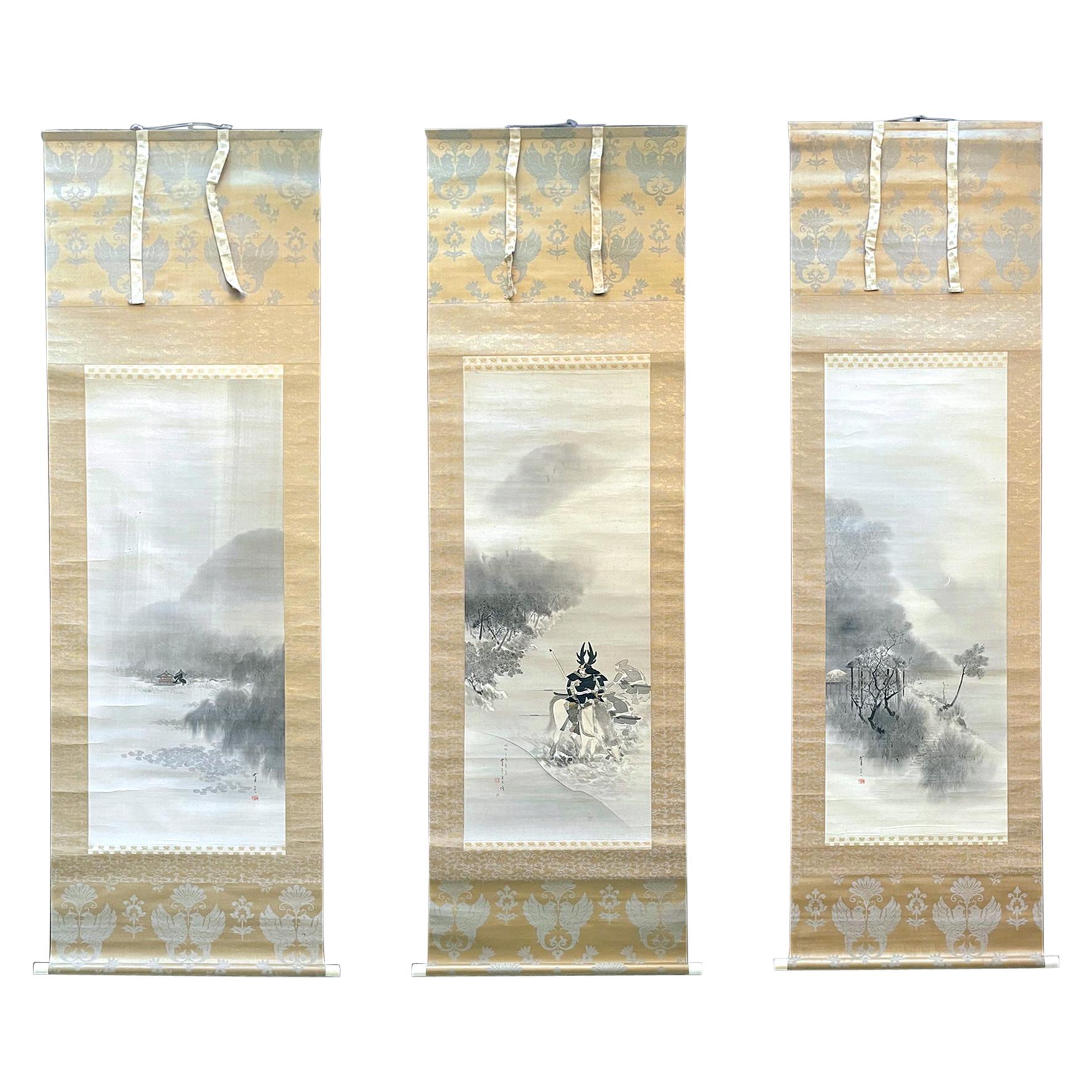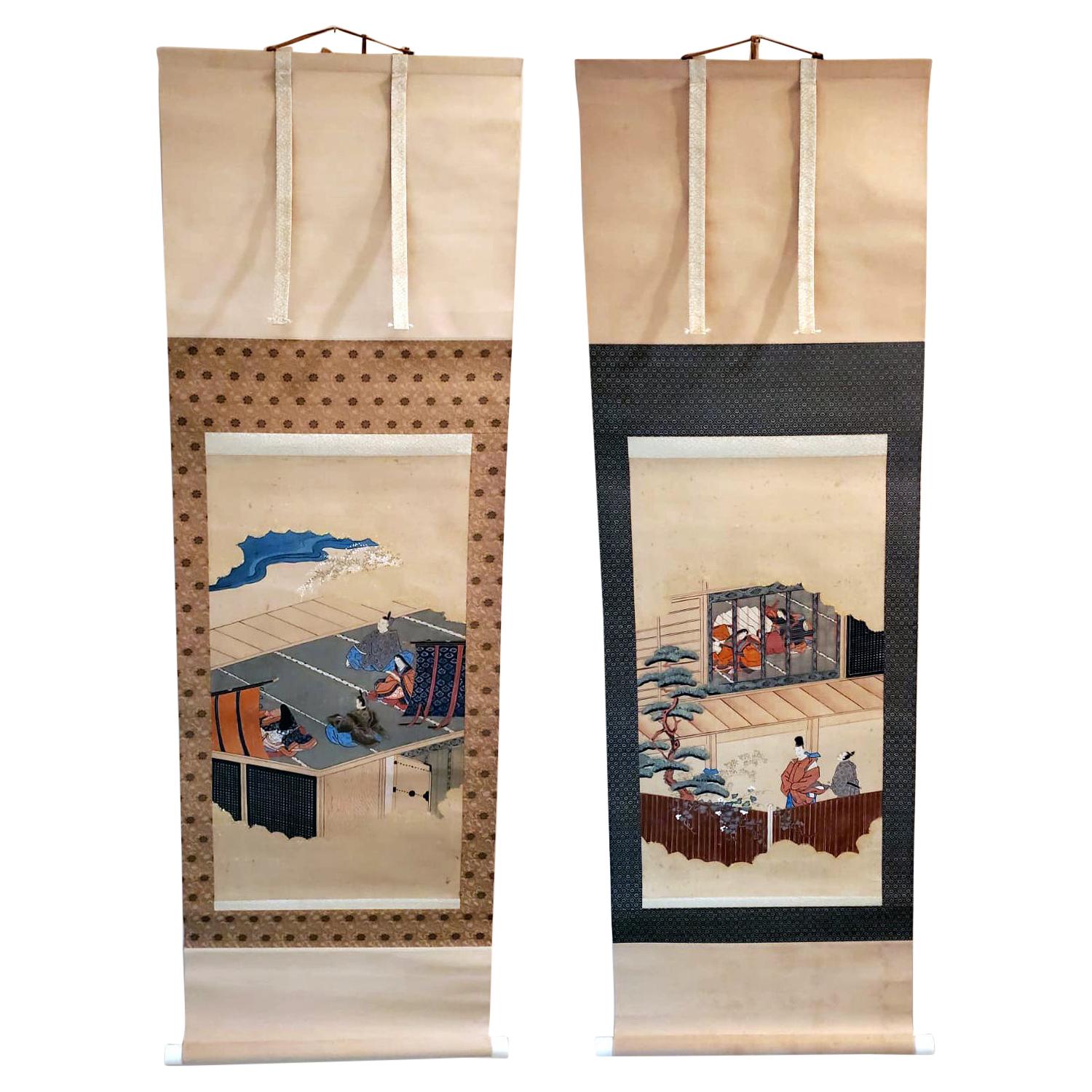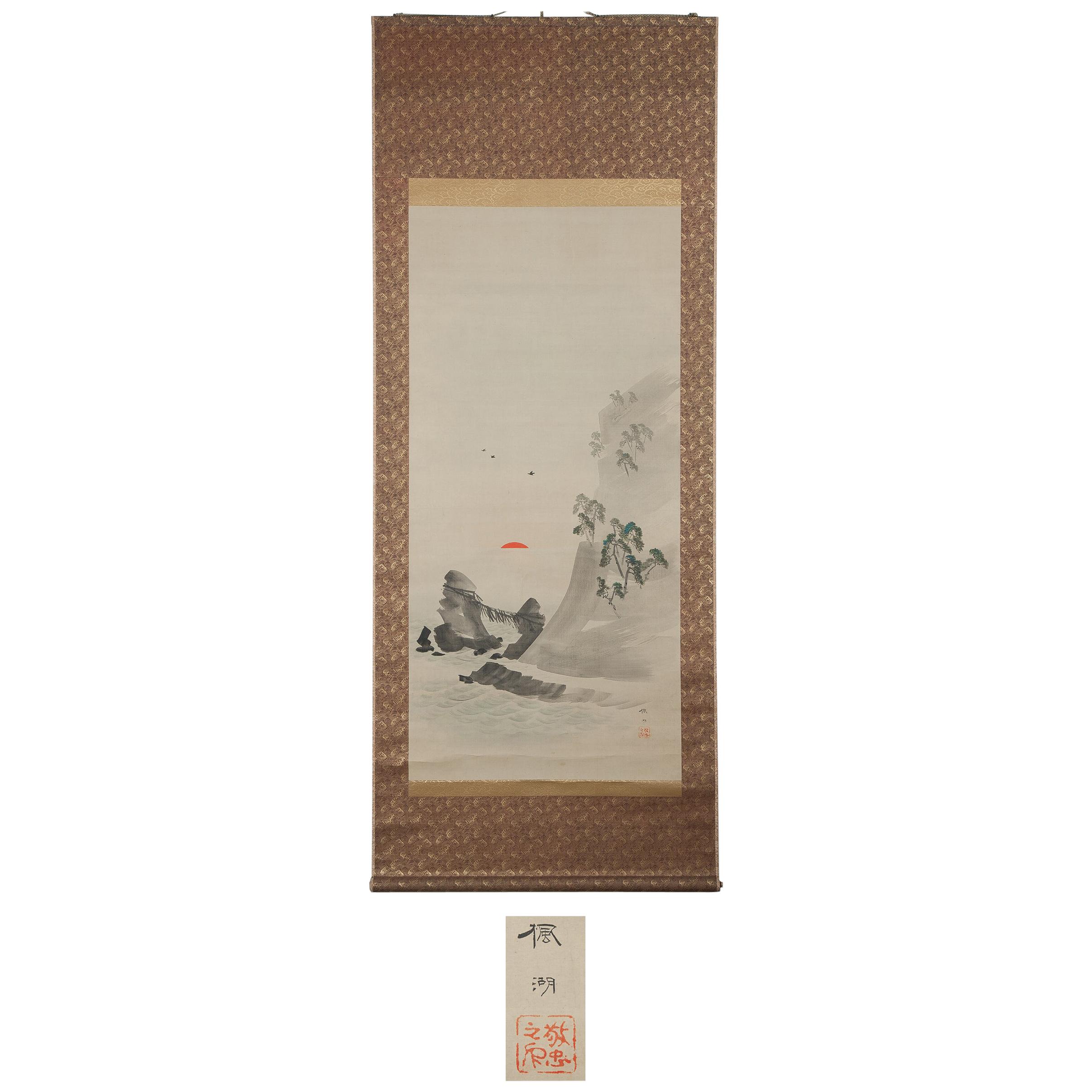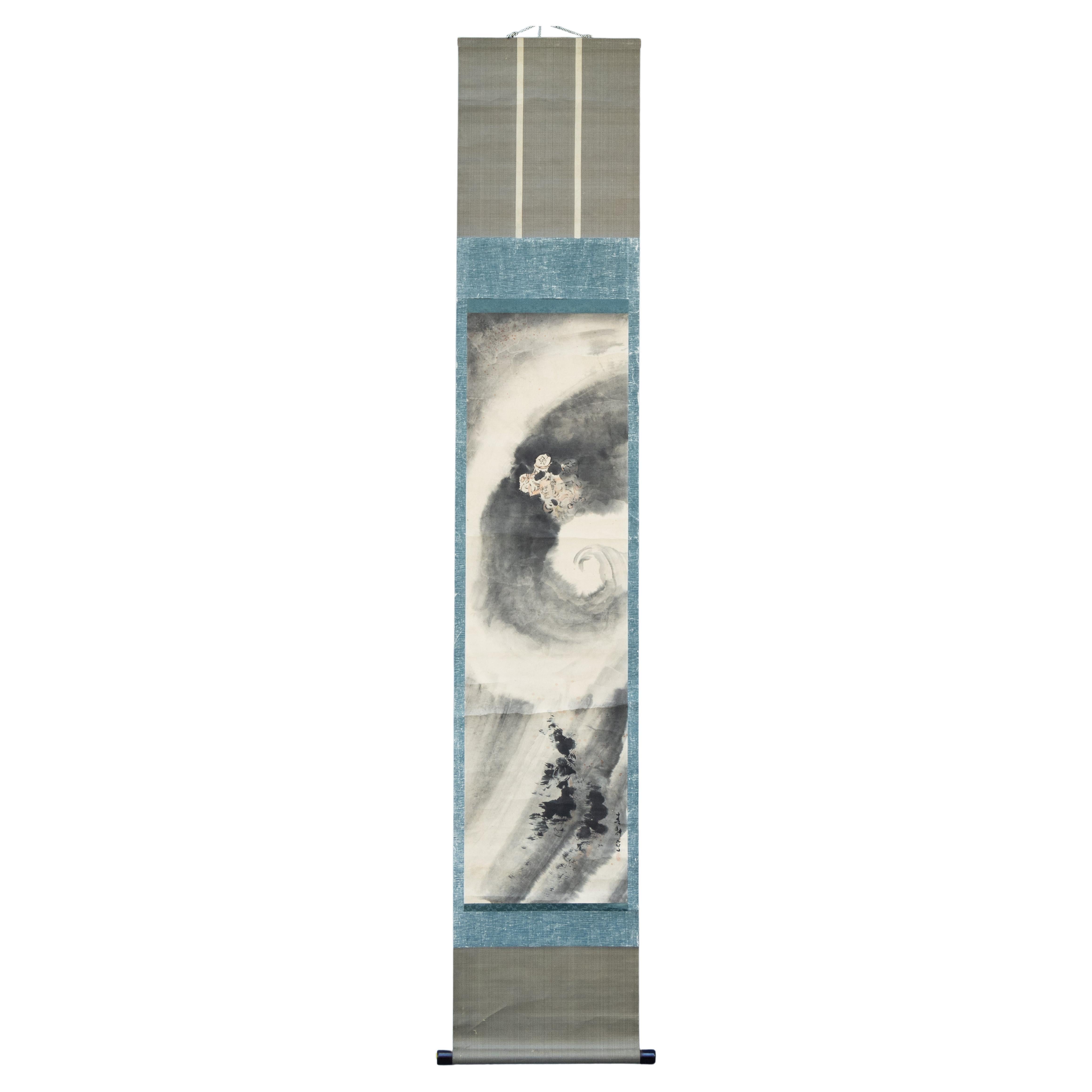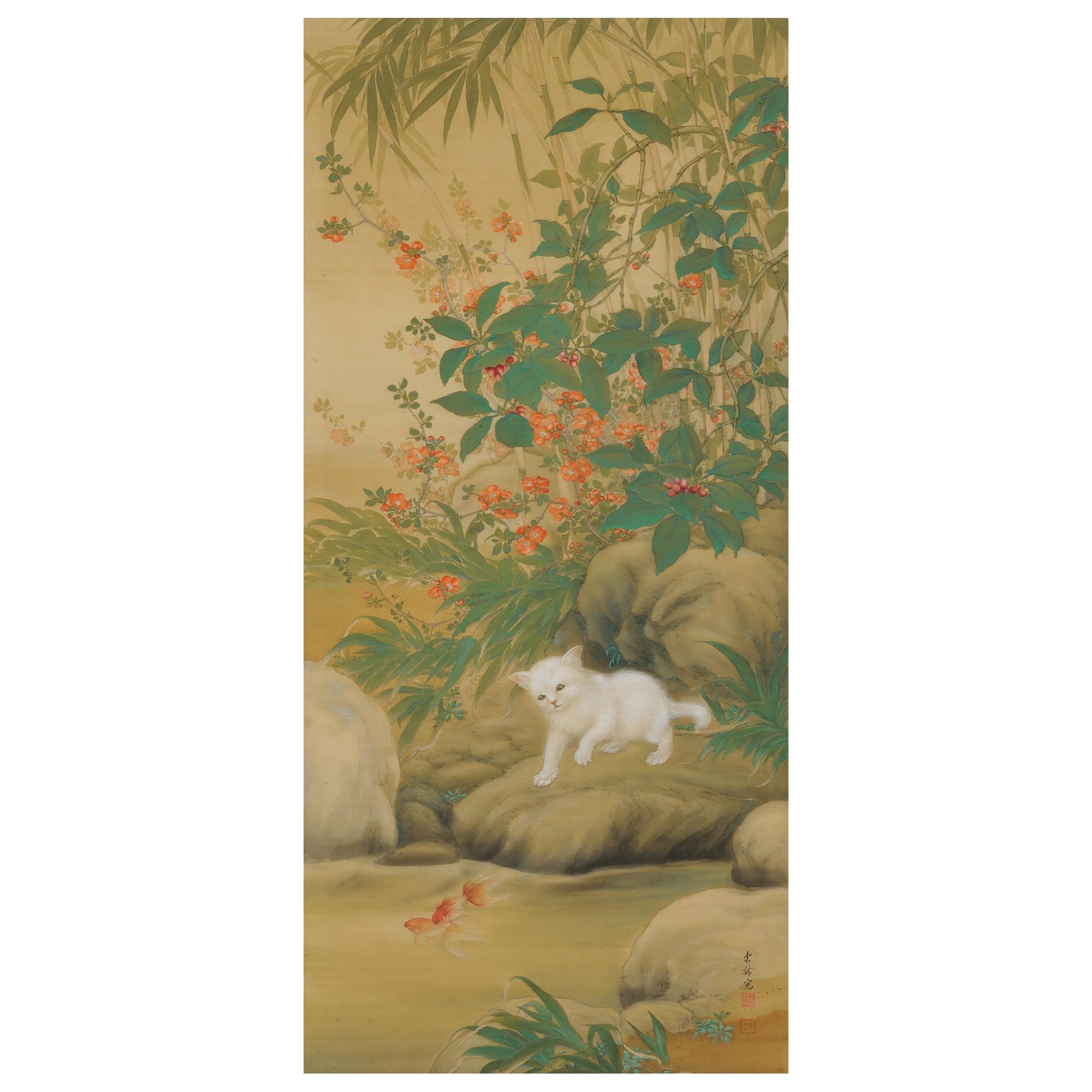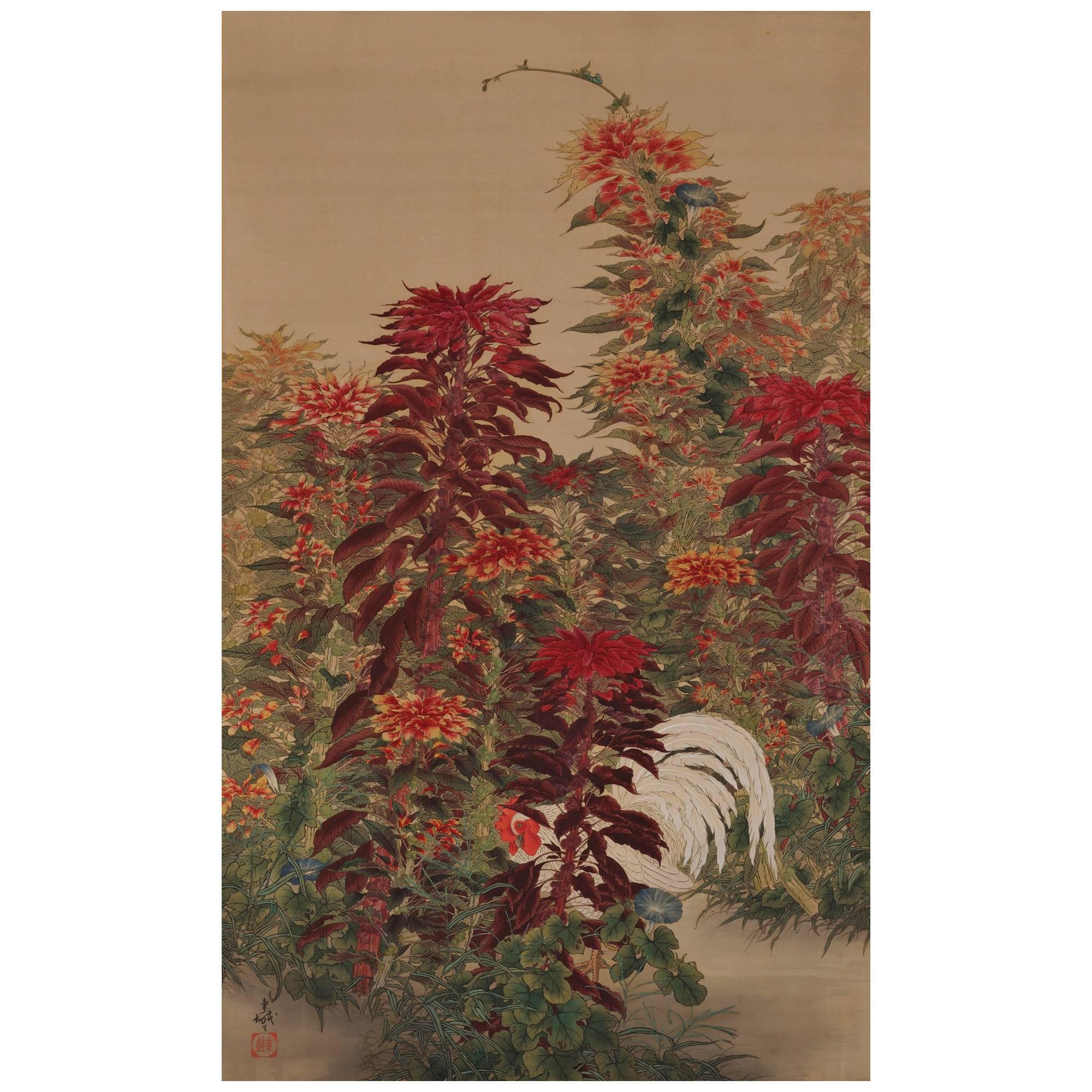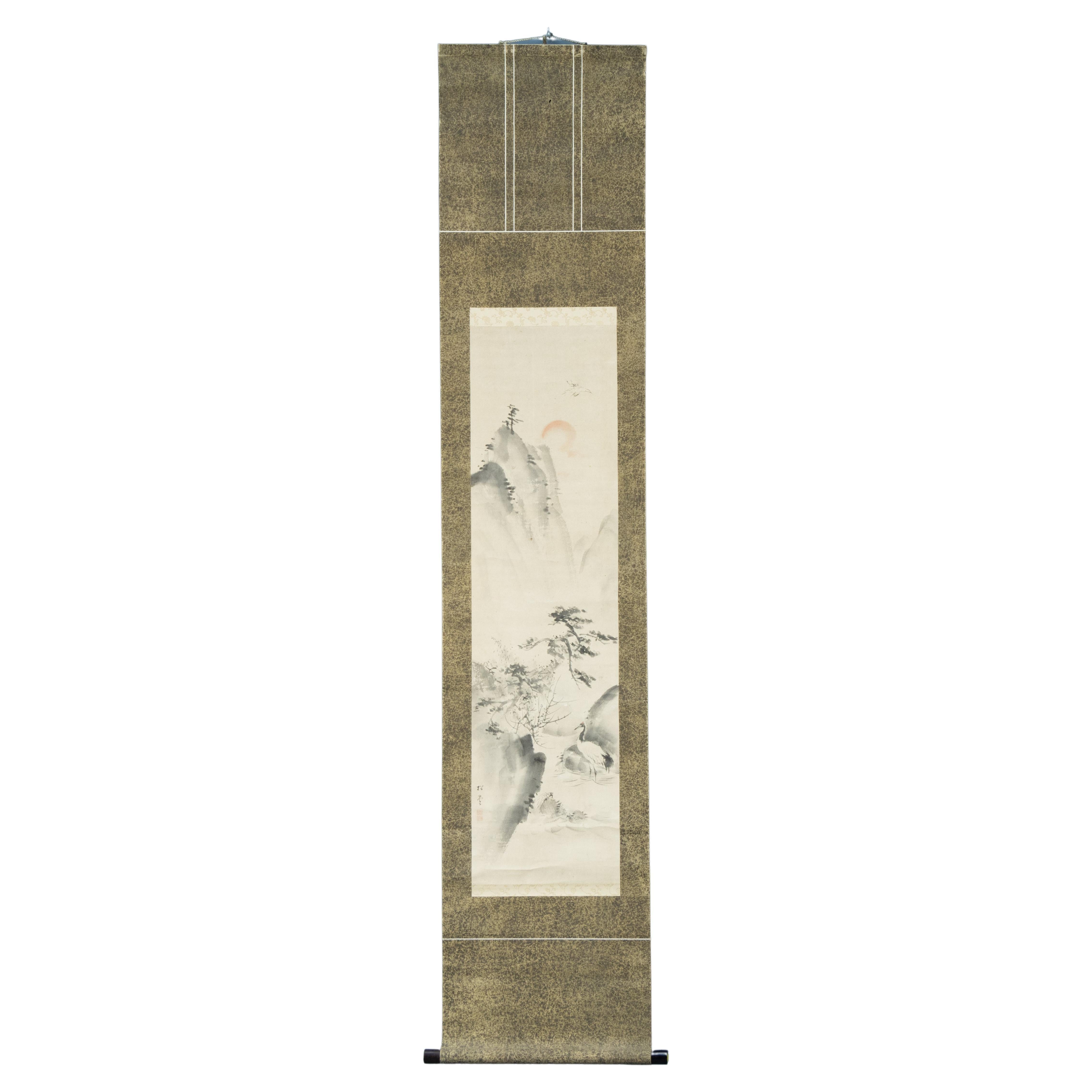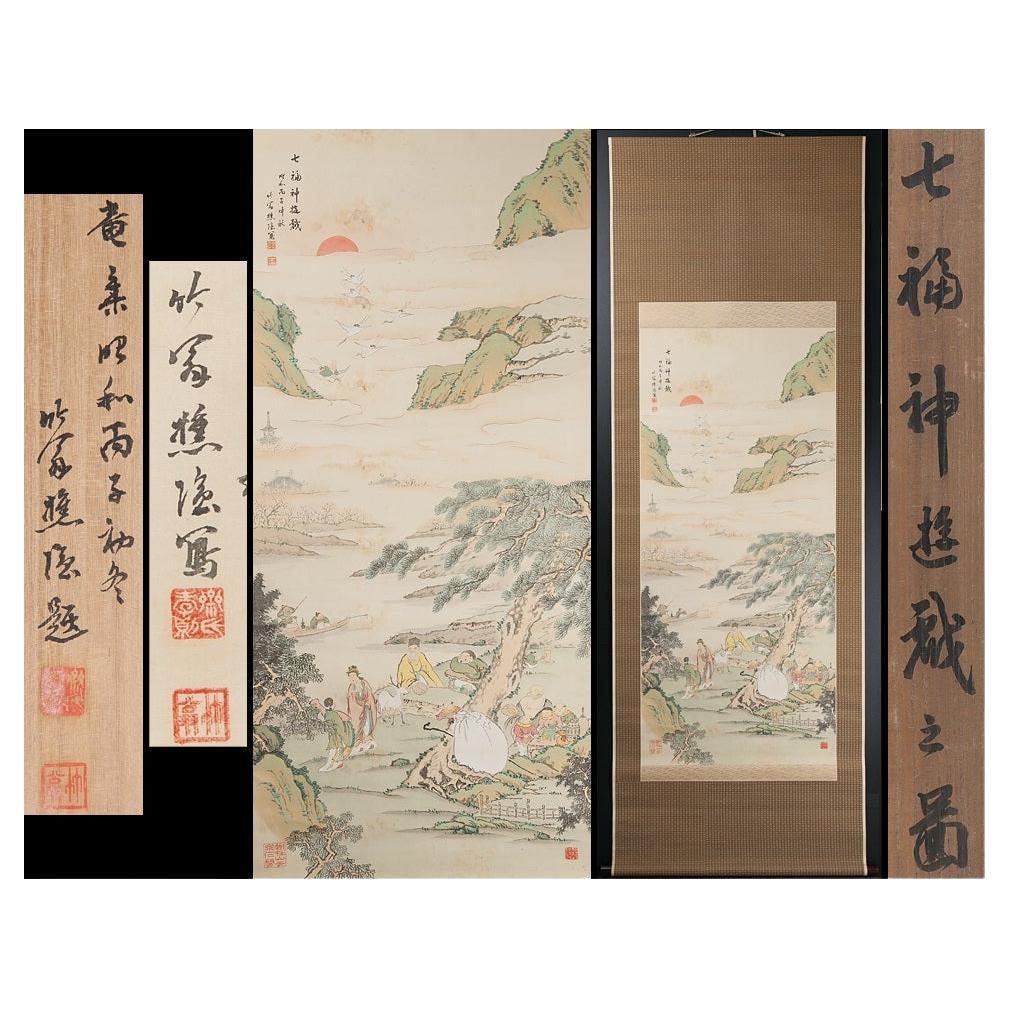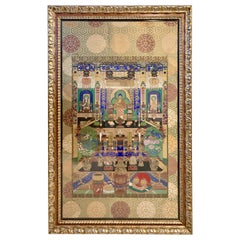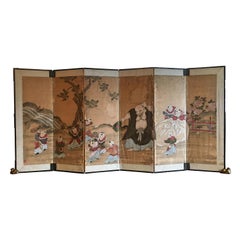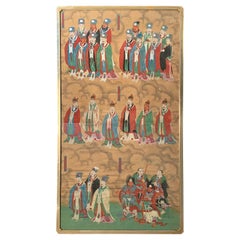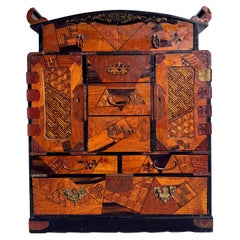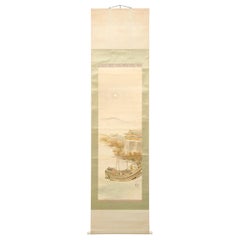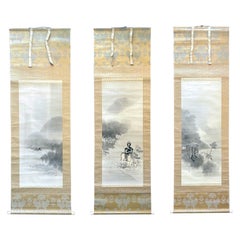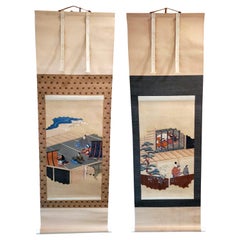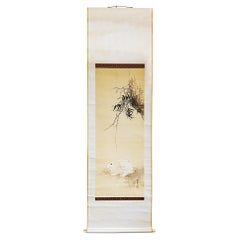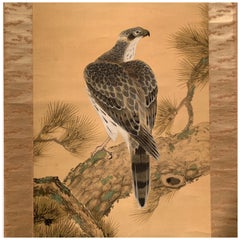
Hawk on Pine, Japanese Hanging Scroll Painting by Shunsen, Meiji Period, Japan
View Similar Items
Want more images or videos?
Request additional images or videos from the seller
1 of 12
Hawk on Pine, Japanese Hanging Scroll Painting by Shunsen, Meiji Period, Japan
$2,200List Price
About the Item
- Dimensions:Height: 84.5 in (214.63 cm)Width: 21 in (53.34 cm)Depth: 1 in (2.54 cm)
- Style:Meiji (Of the Period)
- Materials and Techniques:
- Place of Origin:
- Period:1900-1909
- Date of Manufacture:circa 1900
- Condition:Wear consistent with age and use. Minor structural damages. With one small tear to the top of the scroll. Some creases and buckling from rolling. One large crease to the painting towards the bottom.
- Seller Location:Austin, TX
- Reference Number:1stDibs: LU894719104172
About the Seller
5.0
Gold Seller
Premium sellers maintaining a 4.3+ rating and 24-hour response times
Established in 2001
1stDibs seller since 2010
346 sales on 1stDibs
Typical response time: 1 hour
Authenticity Guarantee
In the unlikely event there’s an issue with an item’s authenticity, contact us within 1 year for a full refund. DetailsMoney-Back Guarantee
If your item is not as described, is damaged in transit, or does not arrive, contact us within 7 days for a full refund. Details24-Hour Cancellation
You have a 24-hour grace period in which to reconsider your purchase, with no questions asked.Vetted Professional Sellers
Our world-class sellers must adhere to strict standards for service and quality, maintaining the integrity of our listings.Price-Match Guarantee
If you find that a seller listed the same item for a lower price elsewhere, we’ll match it.Trusted Global Delivery
Our best-in-class carrier network provides specialized shipping options worldwide, including custom delivery.More From This Seller
View AllLarge Framed Japanese Buddhist Amida Temple Hall Painting, Mid-19th Century
Located in Austin, TX
A large and incredible Japanese painting of a Buddhist temple hall with Amida Nyorai, late Edo or early Meiji period, mid-19th century, Japan. Mounted wit...
Category
Antique Mid-19th Century Japanese Meiji Paintings and Screens
Materials
Brocade, Silk, Acrylic, Wood, Paint
Japanese Six Panel Screen with Hotei, Edo Period, Early 19th Century
Located in Austin, TX
A delightful Japanese six panel painted paper screen featuring the beloved figure Hotei, Edo Period, early 19th century.
Hotei, called Budai in China, and known as the Laughing Buddha or Fat Buddha in the West, is considered to be an emanation of Maitreya, the Buddha of the Future.
In Japan, he also holds a special place as one of the Seven Lucky Gods, being the god of fortune, and protector of children.
He is always portrayed as a mirthful and corpulent man, dressed in loose robes that show off his round belly. He carries a sack with him, said to be filled with treasure. As the protector of children, he is often portrayed with them playing on or around him, as he is here. The children portrayed in this screen are dressed in Chinese style clothing...
Category
Antique Early 19th Century Japanese Edo Paintings and Screens
Materials
Silk, Paper
Chinese Early Qing Dynasty "Water and Land Ritual" Painting, 17th Century
Located in Austin, TX
An important Chinese 17th century early Qing Dynasty "Water and Land Ritual" painting, mineral pigment and ink on silk, mounted as a scroll, framed and glazed.
The painting depicting groups of heavenly court officials and deities descending from the clouds to participate in the Liberation Rite of Land and Water. The figures all wear full, sumptuous robes, complete with hats indicating their station. The blue, green, red, black and white of the robes decorated with gilt dragon and geometric designs.
This painting is interesting in that it incorporates Daosit deities and heavenly officials coming down to participate in the Buddhist rite. There are five distinct groups of figures, each with a small inscribed plaque. Some of the groups are identified as Tian Xian, or Heavenly Immortals.
The group at the bottom left are identified as the Sanguan Dadi, or Three Great Emperor-Officials. The Emperor of Heaven is dressed in blue robes with gilt painted dragons. The Emperor of Water wears black robes. The Emperor of Earth wears yellow robes...
Category
Antique 17th Century Chinese Qing Paintings and Screens
Materials
Silk, Glass, Giltwood, Paint
Japanese Marquetry Hanging or Table Cabinet, Meiji Period, c. 1900, Japan
Located in Austin, TX
A large and remarkable Japanese lacquer and marquetry decorated table or hanging cabinet, Meiji Period, circa 1900, Japan.
The cabinet of square form surmounted by an arched top with upturned scroll ends. Eight drawers of various shapes and sizes adorn the exterior of the cabinet. Doors on either side open to reveal interiors fitted with cubby holes over a single drawer.
The front of the cabinet is decorated with scattered geometric marquetry patterns of various design utilizing contrasting woods, including hardwood and burl, all in the yosegi zaiku technique.
The sides and top of the cabinet of black lacquer with maki-e lacquer painted designs of flowers and grasses. The back of plain black lacquer with two hoops for hanging.
The interior of the cabinet doors and the interior drawers decorated in the wakasa lacquer technique, with gold rhomboid accents against a polished black lacquer ground.
Overall a striking accent piece and nice example of Japanese yosegi...
Category
Antique Early 1900s Japanese Meiji Furniture
Materials
Metal, Brass, Copper
Japanese Bronze Bamboo Hanging Vase, Kakehana, Meiji Period, circa 1900, Japan
Located in Austin, TX
A subtle and beautiful Japanese bronze hanging flower vase, kakehana, Meiji Period, circa 1900, Japan.
The slim and elegant vessel of cast bronze in the form of a stalk of segmented...
Category
Antique Early 1900s Japanese Meiji Vases
Materials
Bronze
Large Antique Chinese Hand Painted Wallpaper Section in Carved Hardwood Frame
Located in Austin, TX
A wonderfully charming large and colorful Chinese hand painted wallpaper section in a carved and shaped hardwood frame. The wallpaper dates to the first half of the 20th century or e...
Category
Early 20th Century Chinese Chinese Export Paintings and Screens
Materials
Hardwood, Paper
You May Also Like
Japanese Meiji Riverside Scroll Painting, c. 1900
Located in Chicago, IL
Although western painting was initially embraced during Japan’s Meiji period (1868-1912), artists brought on a revival of traditional painting styles as they sought to create a modern Japanese style with roots in the past. This exquisite hanging scroll demonstrates the preference for soft layering of gray tones with judicious use of color. The landscape is rendered in soft ink washes that subtly distinguish between water, mountain, and sky. The scroll painting...
Category
Early 20th Century Japanese Meiji Paintings and Screens
Materials
Paper
Rare Triptych Scroll Paintings by Watanabe Seitei Meiji Period
Located in Atlanta, GA
A set of three paintings of ink and watercolor on silk mounted within brocade borders as scrolls by Watanabe Seitei (1851-1918). This is a very rare an...
Category
Antique Early 1900s Japanese Japonisme Paintings and Screens
Materials
Brocade, Silk, Wood
Two Antique Japanese Hanging Scroll Paintings
Located in Atlanta, GA
Two Japanese scroll painting depicts scenes from the Tale of Genji (Genji-E), from Edo period. These painting were purchased from Odewara Shoten in the...
Category
Antique Early 19th Century Japanese Japonisme Paintings and Screens
Materials
Brocade, Paper
$4,800 / set
Japanese Hanging Scroll, Late 19th Century
Located in New York, NY
A Japanese hanging scroll or Kakejiku, circa 1890, depicting bamboo grass and a rabbit, framed by top and bottom ribbons of brocade silk.
In ...
Category
Antique 1890s Japanese Meiji Paintings
Materials
Silk, Paper
$2,624 Sale Price
20% Off
Lovely Meiji Period Scroll Paintings Japan Meiji Artist Fuko Matsumoto
Located in Amsterdam, Noord Holland
Fuko Matsumoto, order of the rising sun,
Size: Axis, vertical 212.5 cm next to 84.7 cm
Painting, vertical 140.8 cm horizontal 66.7cm ? Differs slightly in size.
Condition: The state is good, but, wrinkle-thin stain
Biography Fuko Matsumoto 1840-1923
Japan painter. Ibaraki prefecture production. Imperial Art Academy member.
Fuko was born as the 3rd son of Matsumoto Soan in Kawachi County of Hitachi Province (Now Inashiki City of Ibaraki Prefecture) on September 14 of the 11th year of the Tenpo era.
His real given name was Toshiro.
In 1853, when Fuko was 14 years old, he went to Edo and studied painting under Oki Ichiga, who was an official painter of Tottori Domain.
Ichiga was a painter who studied the Kano, the Rinpa and the Nanpin styles, and was good at expressing flowers & birds in deep colors.
Later, Fuko studied painting under Satake Eikai, who was best pupil of Tani Buncho...
Category
Antique 19th Century Japanese Meiji Paintings and Screens
Materials
Fabric
$1,120 Sale Price
25% Off
Japanese Meiji Period Painting Scroll Water Spirit Japan Artist Signed
Located in Amsterdam, Noord Holland
Japanse school Watergeest
Rolschildering / scroll op papier, lakwerk rollers. B- 112 x 31.2 / 194 x 35.3 cm
112 x 31.2 / 194 x 35.3 cm
Category
Antique Mid-19th Century Japanese Meiji Paintings and Screens
Materials
Silk
$1,195 Sale Price
20% Off
Recently Viewed
View AllMore Ways To Browse
Antique Hawk Painting
Japanese Screen Hawk
Japanese Painted Screen
Antique Japanese Screens
Vintage Japanese Screen
20th Century Japanese Screens
Antique Chinese Screens
Japanese Screen Black
Antique Japanese Scrolls
Hanging Screen
Antique Brocade
Chinese Wood Screen
Asian Silk Screens And Paintings
Chinese Screen Painted
Silk Screen Paintings
Japanese Silk Screens
Asian Gold Leaf Art
Japanese Bamboo Art

